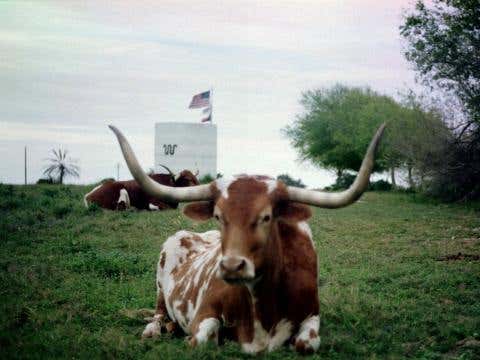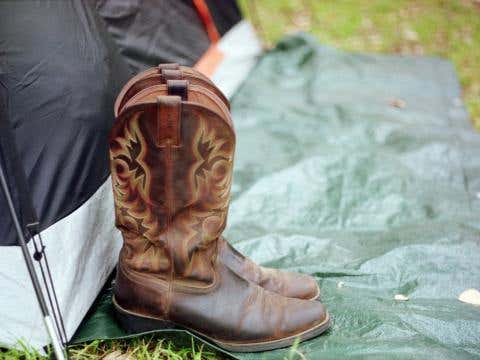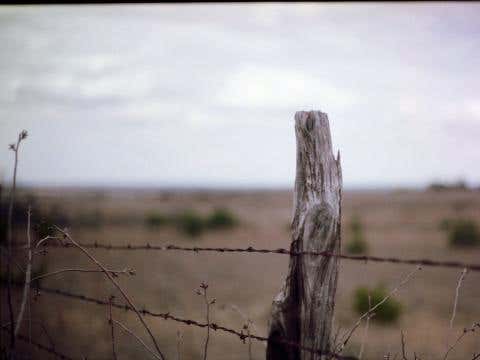
Journey up the Chisholm Trail
Searching for traces of cowboy culture on the Chisholm Trail cattle route from Texas to Kansas
It was raining in downtown Dallas when I first hit the road. A wet spring is good in this part of the country—it means the summer drought won't be quite as bad by the time the triple-digits make their way to Texas sometime in early summer. But for me, it was a bad omen. I was on the first leg of an 8-day camping trip through the middle of the United States. Wet nights make for uncomfortable days on the road.
I was following the old Chisholm Trail, the route hundreds of cowboys used to take millions of cattle from the big ranches in south Texas to the market at the railroad in Abilene, Kansas, during the late 1800s. But today those vestiges are all faded away, and that Texas—nearly lawless and full of danger—is unrecognizable. In a state where we cling to our roots, our traditions, and our legends, where do the phantoms of the old trails fit in? I wanted to know, which brought me to here.
My first stop on the way to the trailhead in south Texas is in West, Texas, a small town of a little over 2,000 people on the I-35 corridor that runs through the center of the state. West is home to a large population of Czech immigrants and the Czech Stop, a 24-hour gas station and kolache stand, which is a standard stop for any Texan making the trek between Waco and Dallas.
The Czech immigrants have been making these fruit– and meat–filled pastries for years the same way their ancestors did back in Eastern Europe. I ordered a cream cheese and strawberry kolache, as well as a pecan roll. The kolaches were sweet and satisfying—just what I needed to keep me going on my way. I kept the pecan log for later; I had a long journey ahead and am not even 100 miles in.
Lockhart, Texas. The main room at Kreuz Market was filled with smoke from the pits. Charles Kreuz, Sr., opened a grocery here in 1900, where he began serving smoked meat with two simple rules that are still gospel today: no sauce and no forks. The light is hazy and when you walk in the building. The men and women behind the counter are stoic. They've been waiting for you, but nobody says anything at first.
“What can I get for you?” In the back, the man with the thick sideburns and the smoke-stained skin started moving. His sideburns made him instantly recognizable; it's the pit boss Roy Perez, who has been smoking meat in this town since before I was born.
In the haze, he opened the lid to one of the huge pits. He reached in and pulled out a thick brisket covered in black bark. He cradled the thing, carefully carrying it over to the butcher’s block. He took out his knife with one hand and caressed the meat with the other. His cuts were smooth and deliberate. Watching him work wa like watching God create light. Out of the haze, there was meat, and he saw that it was good.
The young man at the register stood at the ready, scooping up the slices—a quarter pound of brisket—as soon as the pit boss had sliced them, quickly weighing the meat and wrapping the package loosely in butcher paper. He called out the price and got you on your way to the dining room. Perez saw this and moved over to the young man. He rested a hand on his shoulder and spoke low and slow. “Listen,” the pit boss said. “I want you to take your time. This isn’t a Saturday. You can come over here, wait on it. Take your time.”

There are real cattlemen who come to concerts at the big honky tonks like Billy Bob’s Texas and compete at the indoor rodeo every Friday and Saturday night in Fort Worth, but the big money in the Historic Fort Worth Stockyards comes from out-of-towners.
I grew up just down the train tracks from the Stockyards, in Grapevine, Texas. We’d always bring relatives visiting from out of town here on a train for tourists pulled by a steam engine from 1896. They’d buy a plastic hat and pose for photos with the longhorns. It’s a place made perfect for tourists, people from Not Here to spend money pretending to be cowboys.
But that’s always been the way for the stockyards. Even in the nineteenth century, this northern part of town was known as Hell’s Half-Acre; a bawdry place full of saloons and whorehouses for traveling cowboys to visit on their way north on the cattle drives.
When I pulled into town, I stopped at Fincher’s White Front Store for a new Stetson. I then walked across the street to the White Elephant Saloon and ordered a whiskey. Supplies and liquor. Tourism in the Old West. Not much has changed here in Hell’s Half-Acre.
When I was in Gonzales, I saw my first real sign of the trail: Chisholm Veterinary Clinic. Since then, it's been almost non-stop. Chisholm Trail RV Park. Chisholm Trail Shopping Center. Chisholm Trail Executive Building. Chisholm Trail Estates. Chisholm Trail Casino. Almost every city in Oklahoma along the state's historic Chisholm Trail Corridor has a Chisholm heritage center or museum.
In Oklahoma, I stopped at the grave of the man who loaned his name to this symbol of the dying west: Jessie Chisholm. He, a trader, is synonymous with the cowboy legend.
Chisholm was a Scotch-Cherokee trader from Tennessee who set up a series of trading posts in the Indian Territory, making a safe trail through the territory to Kansas in the north. The first cattle traveled on the Chisholm Trail around 1867; Chisholm died in 1868. He was buried here at Left Hand Spring, where a friend wrote his epitaph: “No one left his home cold or hungry.”

There was one of those 1960s Westerns on in my room at the Holiday Inn in Abilene, Kansas, when I turned on the TV. Clean faces and clean action. No swelling snake bites, no fever, no being trampled in a stampede, no being drowned in a treacherous river crossing.
That danger of the West is what attracts us to the cowboy myth, but that’s all it is: a myth. Cowboy life was not just hard and dangerous—it was dirty and unrespectable work. We celebrate these cowboys because we associate them with the freedom of the open range. I wanted a piece of that freedom when I first set out on the trail. I wanted an escape from the concrete and steel of Dallas and found just a piece of that freedom out on the Chisholm. Yet even here in Abilene, one of the first great cowtowns, there’s hardly anything left. There’s no finish line, no marker signifying the end of the drive, 2,170 miles from when I started.
I had dinner across the parking lot from my hotel room at the Brookville Hotel, a family-style chicken dinner establishment that traces its roots back to the 1870s, when it was built as a waypoint for the Chisholm cowboys. They serve a full meal of fried chicken and all the requisite sides—slaw, mashed potatoes, creamed corn and homestyle biscuits. Even the hotel isn’t quite the same. It moved from Brookville, Kansas, to it’s current spot in Abilene in 2000 to be closer to I-70. Despite its unusual success through the 20th century, a dinner spot that had hosted real, live cowboys didn’t have a place in the 21st, and had to be moved.
No, there’s not much left of their trade today, at least the way the cowboys did it. But drive up Kansas 15 from Wichita, and look to the west. There, along the bluffs in the ranchland, you’ll see the last physical marker of the old drives. Parallel furrows in the hard ground running toward Abilene, the tracks left by hundreds of wagons heading north from Texas.
Keep Reading
Continue to Next Story










